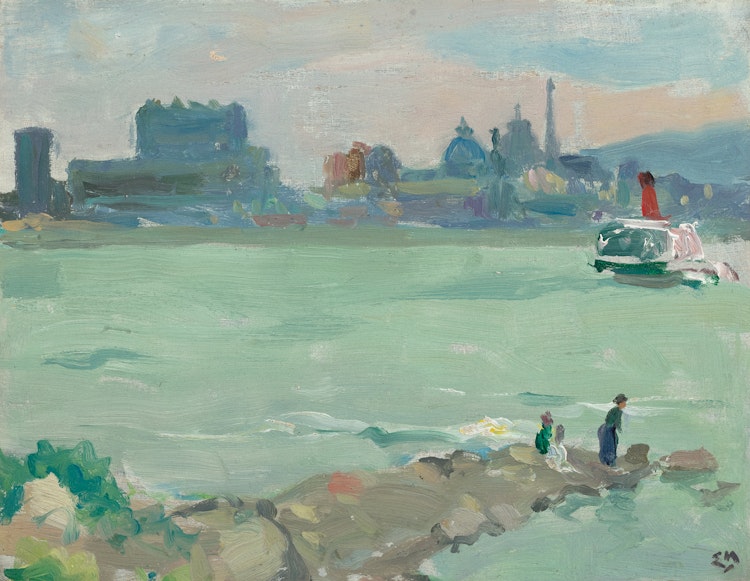The Ferry, Quebec by Edwin Headley Holgate

Edwin Holgate
The Ferry, Quebec
oil on panel
signed with initials lower right; signed, titled and dated 1919 on the reverse
5.5 x 7 ins ( 14 x 17.8 cms )
Auction Estimate: $18,000.00 - $22,000.00
Price Realized $24,000.00
Sale date: November 22nd 2021
Dominion Gallery, Montreal
Galerie d’art Michel Bigué, St-Sauveur
Private Collection, Toronto
Eds. Rosalind Pepall and Brian Foss, “Edwin Holgate”, Montreal Museum of Fine Arts, Montreal, 2005, reproduced page 103
Holgate enlisted in the military during the First World War and carried his sketchbook wherever his postings brought him in Europe. Upon returning to Montreal in 1919 he married Mary Frances Rittenhouse. The new couple travelled to Paris in 1920 and lived abroad for two more years before returning to Canada. During this period Holgate pursued a refined practice and found a renewed sense of identity, akin to the many service men and women who had returned from overseas.
“The Ferry, Quebec”, an early work by Holgate, exhibits parallels to James Wilson Morrice in both subject matter and execution. Viewed from a distance, a lady and children play along the banks of the shore as a ferry chugs towards Quebec City. The viewer observes this scene slightly from above, absorbing both the natural and urban environments with a focus on the soft blue of the St. Lawrence River. A picturesque landscape, Holgate balances the dynamic energy in the urban centre beyond with the calm respite of the outer banks. Executed with a loose handling akin to both Brymner and Morrice, “The Ferry, Quebec” provides a glimpse of Holgate’s acute sensitivities to colour and atmosphere, which develop fully in his mature body of work.
Share this item with your friends
Edwin Headley Holgate
(1892 - 1977) Group of Seven, Canadian Group of Painters, Beaver Hall Group, RCA
Edwin Holgate was born in Allandale, Ontario. Holgate began his art education at the Art Association of Montreal studying under William Brymner who was also A.Y. Jackson's teacher. In 1912 he went to Paris where he studied at the Académie de la Grande Chaumière under Claudio Castelucho and later under Lucien Simon and René Ménard. He was in Russia at the outbreak of the First World War. He returned to Canada where he enlisted and served with the 5th Canadian Division Artillery in France (1916-19). He married Mary Frances Rittenhouse in 1920 and returned to Paris where he continued his studies. There he attended the Colarossi under Adolph Milman, a Russian refugee.
He returned with his wife to Canada in 1922 and opened a studio. He taught wood engraving at the Ecole des Beaux Arts for six years. In Montreal he enjoyed the friendship of A.Y. Jackson, Clarence Gagnon, Mabel May, Lilas Newton, Randolph Hewton, and many of the younger artists who became known as the Beaver Hall Hill Group. Holgate was a good skier and he would take trips to various parts of Quebec to sketch during the winters, sometimes at Baie St. Paul where A.Y. Jackson, Clarence Gagnon, Mabel May and others would congregate.
In 1926 he accompanied A.Y. Jackson and Marius Barbeau to the Skeena River area in British Columbia. Barbeau had been investigating the condition of the Indian totem poles, many of which were restored by the C.N.R. engineer Mr. T.B. Campbell. Holgate and Jackson made a number of sketches of the poles and the Indian villages in the area. From his sketches, Holgate made several large canvases. One is in the collection of the National Gallery and entitled is “Totem Poles, Gitsegiuklas”.
Holgate became the eighth member of the Group of Seven in 1931 and remained a member of the Group until it disbanded in 1933. From it arose the Canadian Group of Painters of which he was a founding member. Paul Duval noted that Holgate and Varley were the only members of the Group who drew and painted nudes. Holgate was well known also for his portraits and did many striking character studies of inhabitants of Canadian bush country. The Art Gallery of Ontario and the National Gallery of Canada have his nude studies in their collections.
During the Second World War, Holgate served overseas as an official Canadian war artist with the R.C.A.F. and painted mainly portraits of flying officers. Holgate’s wood-engravings are exceptionally well done and interesting. He was a member of the Royal Canadian Academy (A.R.C.A. 1934 - R.C.A. 1935). His work has been exhibited in many group shows over the years. He is represented in many collections including the National Gallery of Canada, the Art Gallery of Ontario, the Art Gallery of Hamilton and the McMichael Collection.
Source: "A Dictionary of Canadian Artists, Volume II”, compiled by Colin S. MacDonald, Canadian Paperbacks Publishing Ltd, Ottawa, 1979

